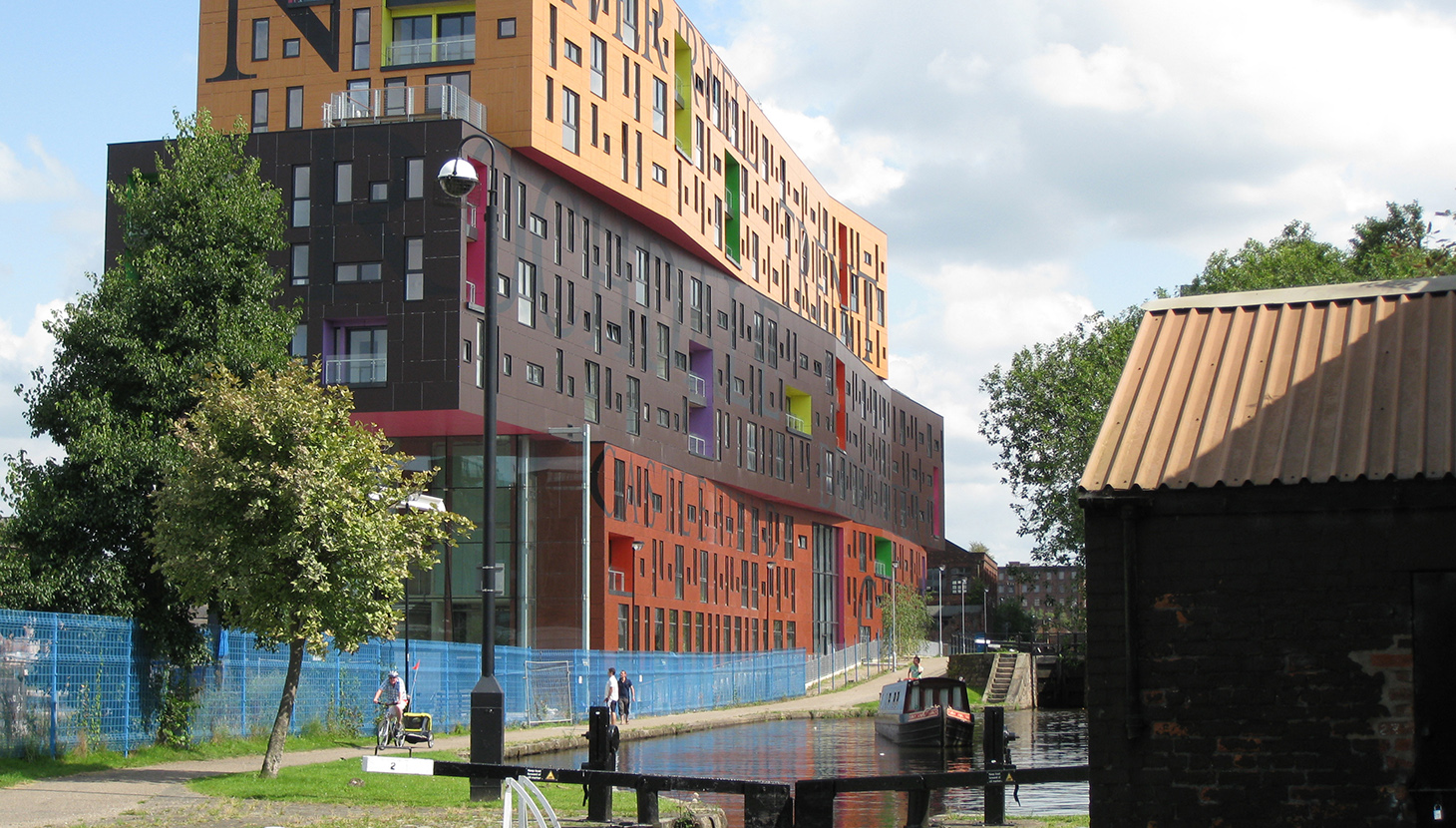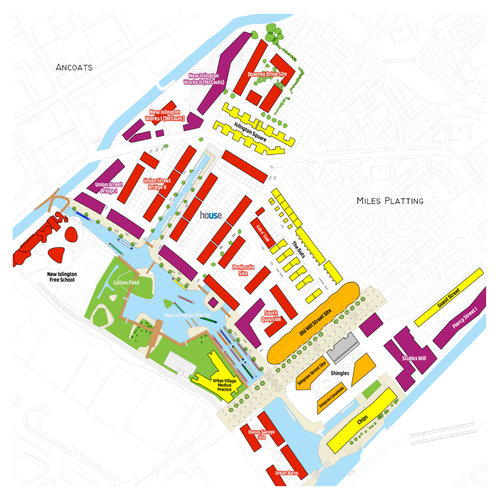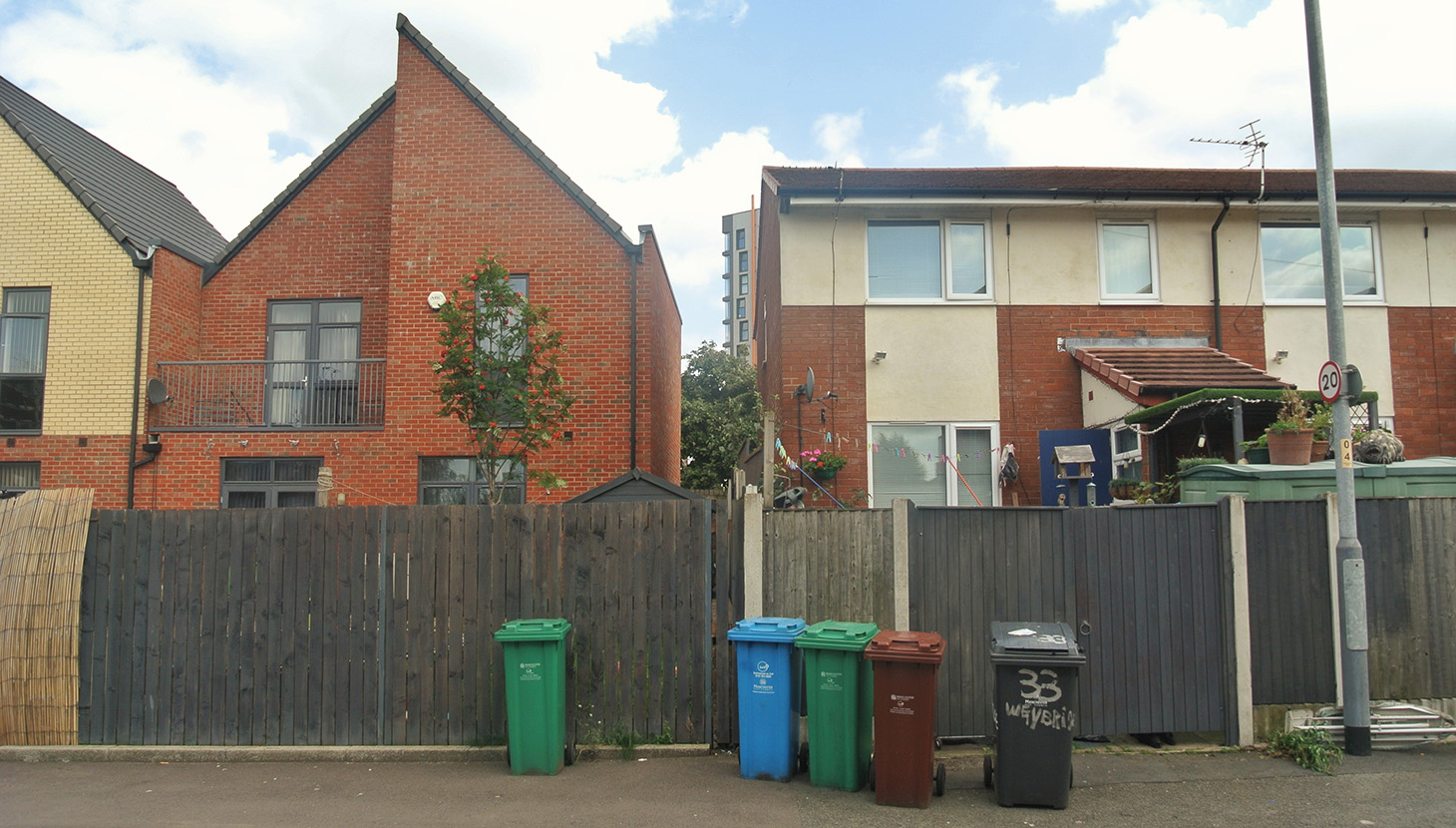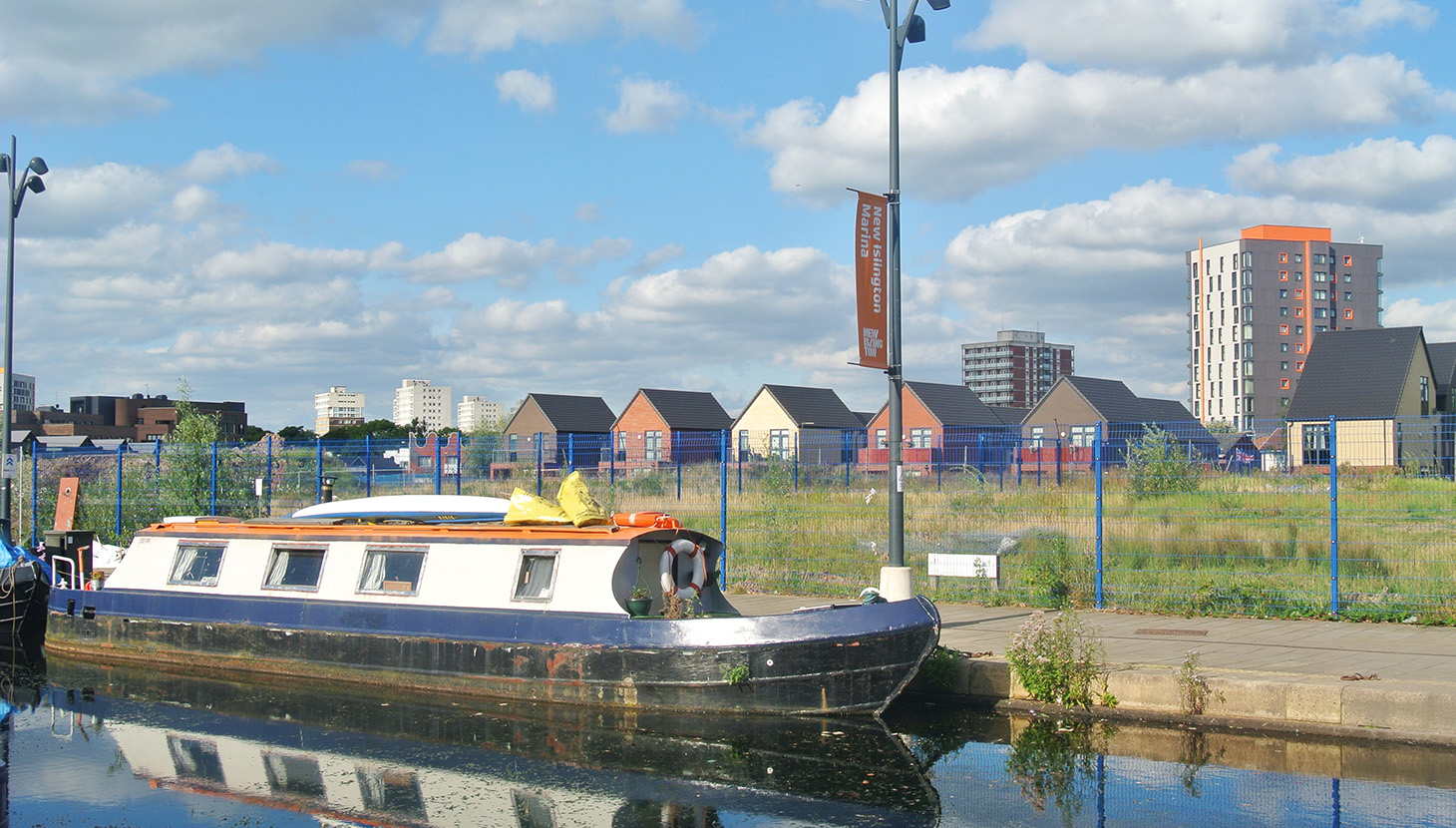
There is no more obvious, and usually contentious, divide within cities than along the border of two distinctly different neighbourhoods. These spaces can serve to disrupt our urban experience, and are often breeding grounds for tension and conflict. In East Manchester the development of New Islington, right next to Miles Platting, has seen an attempt to blur these inter-neighbourhood divides. Here, Lucy Sykes considers just how effective it has been in its efforts.
Subtlety is hard to come by in New Islington. Basking in the industrial spires of Ancoats, what currently exists of this new neighbourhood is loud, brash and absolutely in your face. The 25 acre site offers a new waterway, an eco-park, contemporary design and an impressive number of geese. Cranes have stood like markers and pointed Manchester in the direction of this development for years, but the constant sound of construction and vacant plots remind us there is a lot more to come. In an otherwise gloomy and well-worn city, New Islington is the saving grace of modern design, and almost every young professional within Manchester has been tempted by the bubble gum masterplan, close enough to the Northern Quarter to hear the cocktails shaking and the avocados smashing.
But it is here that one of Manchester’s biggest divides comes to life. New flats are pressed hard up against weathered family homes and apartment balconies look into the gardens of dated terraced council houses. To the east of New Islington a much older, less polished neighbourhood remains. Smooth paved streets turn to pot-holed nightmares as the physical divide across these neighbourhoods translates into a bike riding hell.
In terms of inter-neighbourhood divide, it would be difficult to find a place which exhibits it as crudely as here. The point where New Islington meets Miles Platting is where redevelopment meets deprivation. It is the urban borderland where, to look at, there couldn’t be a starker contrast between the physical fabric of the two communities. But various methods have been adopted to try and smooth these differences, and the area can be seen somewhat as a case study as to how, or maybe how not, we urbanists can use design and planning as a tool to connect communities rather than segregate them further. For this, we have Urban Splash to thank. The property moguls of the north-west are responsible for the masterplan which has seen the ongoing delivery of Manchester’s most visionary and wanted neighbourhood, right on the doorstep of its most deprived.
Understanding the history of the site can help us to see why the development of New Islington has been so contentious. Prior to the development, the area was known as the Cardroom Estate, a late 1970’s neighbourhood which was less about design and more about functionality. It offered a low density solution to housing need; 200 council owned units propping each other up with large gardens and quiet streets. As in Miles Platting, it offered a much needed cluster of social housing within Manchester.
It could have been a success too, had its development not coincided with economic turmoil for the city. The late 20th century saw the industrial heart ripped out of Manchester. The birthplace of the world’s first industrial empire was being restructured; manufacturing was outsourced in favour of a service based economy. The grafters of Cottonopolis were left without jobs, and in the spiral of economic decline, East Manchester emptied.
The vacant landscape was primed for dissent as the estate became victim to its undesirability, to its cul-de-sac design, darkened alleyways and lack of surveillance. The problems which had previously been associated with high density council flats were being realised on the streets. A few residents remained loyal, resilient to the sinking of their estate and getting used to having fewer conversations over the garden fence. They duly watched as the Cardroom Estate fell into worryingly low census-data territory and as the reputation of their homes became tarnished by association.

ph. Urban Splash
Urban Splash came onto the scene at the turn of the Millennium when, in 2002, funding was secured to redevelop the estate as the UK’s third new Millennium Village. Tasked with creating a new neighbourhood where the old Cardroom Estate stood and right next to Miles Platting, Urban Splash not so humbly went about turning, in their own words, the ‘dreary to the desirable’. The masterplan offered colour and quirkiness and housing on stilts. It was going to be one of the ‘most ambitious regeneration projects in the world’ claimed Nick Johnson, the previous development director for Urban Splash, based on inclusivity and mixed use.
Just how well they achieved this vision has since been speculated. There is no doubt that the gentrification critique looms heavily over New Islington, but I wanted to explore some of the ways Urban Splash tried to ease the blow of their extroverted development plans. I look here to see exactly what they did to help achieve cross-neighbourhood cohesion over the physical and social realms of space.
The Urban Splash approach
To ensure social inclusion between the new and the old neighbourhoods, consultation was, as expected, a crucial part of the process. Residents were invited to select out of a shortlist an architect to deliver one of the first phases of social housing- Islington Square. They picked FAT architects who, rather than giving a more formal presentation like other bidders, sat down with them and started a conversation with a brew, listening to their design preferences. With the demolition of the vast majority of the site, the association with the Cardroom Estate was rinsed clean through a radical rebranding exercise with the local’s name of choice, ‘New Islington’, being plastered on every construction fence. Heeding to the demands for housing variety, Urban Splash incorporated low-density family homes into their masterplan. With inclusion in the consultation and design process, this was going to be a neighbourhood for the people.
The recession offered an unexpected opportunity for the development to be processed by locals. With work grinding to a halt, New Islington began to look more like a failed ambition rather than East Manchester’s utopia. But the gift of time has allowed the initial units to become weathered, to lose some of their shine and scrutiny. No longer standing like unwanted guests at a party, the ‘new builds’ have become more consistent with their neighbours.

In addition to Islington Square, the first phases of development have since seen The Guts (Mae Architects) and a stretch of terraced housing by architect de Metz Forbes Knights, both offering a mixture of shared ownership and social housing, incorporating tenure blind design into the neighbourhood. The handful of pre-existing residents were invited to opt into a ‘Right to Return’ scheme, allowing them to move back into a brand new house once it was built. The New Islington free festival of 2006 offered an annual opportunity for old and new residents to meet to the sound of Mr Scruff, whilst simultaneously drawing the city’s attention to the area.
With regards to bridging the physical divide, units of the initial phases stuck religiously to a tricolour palette of red, grey and beige, allowing for symmetry with the older units across the streets. With ambitions for ‘the best chippy, the Indian Takeaway, a beautiful laundrette, a great pub as well as a poncey wine bar and a three star Michelin restaurant’, Johnson had promised mixed use to provide services for everyone but, a decade since the first housing units were built, only a local chemist is actually open.
A cohesive community?
But have the festivals, consultations, and efforts for inclusion been enough? Despite the attempts made by Urban Splash, it still does feel as if a kink exists between the communities. Janet, whose house looked directly onto the new developments, told me how she had lived in the area her whole life and raised six kids on the Cardroom Estate. Rather than cohesion, she feels strongly disconnected from what is happening over the road. ‘They’ve taken the community out of it here’ she tells me, ‘We’ve been the ones who have had to sit through the dust and noise for houses we’re never going to be able to afford, and live next to people in flats who we are never going to meet’. The failure to provide the mixed uses is another issue for Janet. ‘There’s no social clubs, no shops, no nothing…they’re just crowding us with housing,’ she said.

Furthermore, most of the affordable and social housing provision to date has been squeezed along the border of the development site rather than pepper-potted throughout, the location of which feels more peripheral than welcoming. A recent art installation has captured a snap shot of local opinion perfectly. Presented on the border of New Islington, the Voice Up project shows sketches of residents alongside a quote. ‘They said there would be rich and poor people living side by side – it would be like salt and pepper’ says the obviously concerned sketch version of Lillian, ‘but we don’t mix’. Kate apparently shares the same sentiment; ‘I sometimes feel like a trespasser, as if I shouldn’t be here,’ she says, followed by a rather haunting sketch of Roisin who reckons the area ‘needs more buzz’. For now it seems that the borderland frustration still does exist.
Lessons learnt
Emerging out of the other side of the recession, work in New Islington has restarted. The pre-fab, modular housing units, House (designed by ShedKM) have been built and snatched up by buyers, albeit with no social housing provision. Stubbs Mill has been converted into office space, and a number of higher density apartments are growing to the north of the site courtesy of Manchester Life Development Company. A nodal point is taking shape in the form of New Islington Free School, almost completed in its development, and is likely to enable cohesion in the playground at least.
Whether these current developments will smooth or exacerbate the neighbourhoods remains to be seen, but one apparent saving grace is appearing. In a celebration of public space, it is the completion of Cotton Fields and the marina where the merits of any sort of inclusion lie. Providing wooden enclaves and walkways, an urban beach and distinctive Scots Pines, Cotton Fields offers breathing space for the neighbourhoods to come together.
What’s more, it allows for affordability in the form of colourful canal boats right at the heart of New Islington. ‘We call it the beach’ Janet tells me, ‘We couldn’t drag the little ones away from it this summer’. Testament to her word, you can usually find the area being used for various BBQ, fishing and dog walking purposes. For a city with little in the way of dedicated public areas, it provides a unique platform to combat the critics of the development. It will be here that the true mix of the neighbourhood will be proven.
Although in the midst of its completion, New Islington reinforces various lessons about the importance of mixed use, the value of consultation, tenure blind design, housing variety and siting as methods for cohesion between communities. Social events and a generous time scale obviously have had a part to play as well. But what appears to be the most valuable asset to help dissolve community tensions really does seem to rest on the provision of an accessible and inclusive public space, something that we as planners and designers know the merit of only too well.
Lucy Sykes is a Young Urbanist and works as a graduate planner in Manchester.
Sustainable Urban Neighbourhoods Network (SUNN) Lessons from Ancoats Urban Village and New Islington Millennium Village, Manchester (2011), Available: http://media.urbed.coop.ccc.cdn.faelix.net/sites/default/files/Ancoats%20and%20New%20Islington%20report_0.pdf Accessed: 02/09/16
Len Grant, Ancoats Voice Up 2015-2016, Available: http://www.lengrant.co.uk/work/ancoats-voice-up/, Accessed: 02/09/16